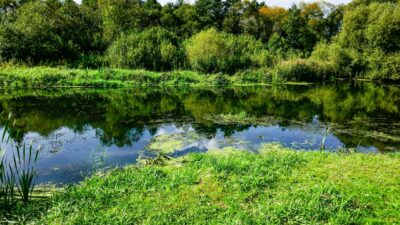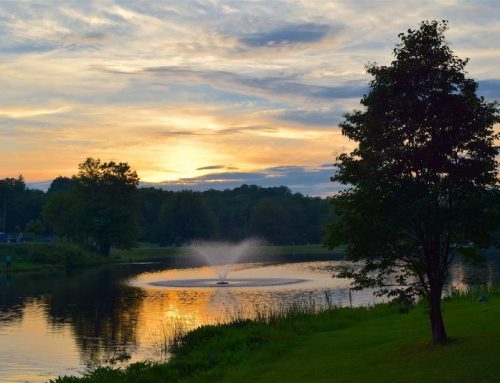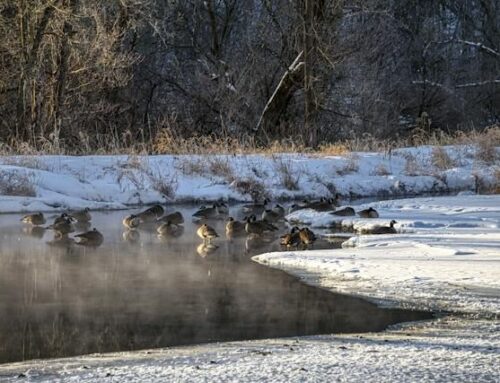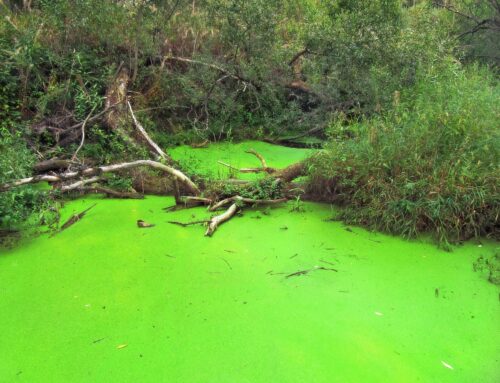 Retention ponds are essential components of urban and rural landscapes, serving to manage stormwater runoff, prevent flooding, and improve overall water quality. As such, it is crucial to maintain these ponds properly and address any repairs or issues as they arise. This guide to retention pond maintenance in Rochester and Upstate New York focuses on retention pond maintenance, repair, and management throughout the Rochester and Western New York area, Central New York, and the Southern tier. With professional farm and retention pond maintenance and pond cleaning services, you can enjoy the benefits of a well-maintained pond while avoiding costly future repairs.
Retention ponds are essential components of urban and rural landscapes, serving to manage stormwater runoff, prevent flooding, and improve overall water quality. As such, it is crucial to maintain these ponds properly and address any repairs or issues as they arise. This guide to retention pond maintenance in Rochester and Upstate New York focuses on retention pond maintenance, repair, and management throughout the Rochester and Western New York area, Central New York, and the Southern tier. With professional farm and retention pond maintenance and pond cleaning services, you can enjoy the benefits of a well-maintained pond while avoiding costly future repairs.
Retention Pond Maintenance Importance
Retention ponds are critical for managing stormwater runoff, particularly in urban areas where impervious surfaces like roads, buildings, and parking lots can exacerbate flooding and erosion issues. Proper retention pond maintenance ensures that these ponds continue to function effectively, reducing the risk of downstream flooding, pollutant discharge, and other potential problems.
Maintaining retention ponds is essential for preserving water quality, supporting local ecosystems, and enhancing the aesthetic appeal of the surrounding landscape. A well-maintained pond will also last longer, providing ongoing benefits for the property owner and the community.
Natural Methods for Retention Pond Maintenance
There are several natural methods that can be employed to maintain and improve the health of retention ponds. These environmentally friendly techniques can often provide effective solutions for common pond issues without the need for harsh chemicals or mechanical interventions.
Triploid Grass Carp. With the required New York State permit, triploid grass carp can be introduced into retention ponds to help control the growth of aquatic plants. According the to the NYS Department of Environmental Conservation, triploid grass carp have distinct feeding preferences, preferring tender, succulent plant species over those that are tough and fibrous. Triploid grass carp will not control emergent species such as cattail or bulrush or floating leaved species such as water shield or water lily. Even among preferred submergent plant species, selectivity and consumption rate varies widely according to a vast array of factors including water temperature, dissolved oxygen and presence or absence of attached algae.
Properly Sized Pond Filtration System. Organic matter discharges nitrogen as it decomposes in a pond. The result might be ammonia, a compound that has nitrogen as a key element, nitrites or nitrates. The organic matter can come from fish waste, dead insects or other animals, or decaying plant material. The presence of nitrogen-based compounds is a part of the life cycle of a pond, but levels do need to be controlled to maintain overall pond health. A good filtration system, correctly sized for the pond, is the best defense against high nitrate levels.
Addition of Beneficial Bacterial to Your Pond. Adding beneficial bacteria to a retention pond can help to improve water quality and clarity by breaking down organic matter and reducing nutrients that can lead to algae blooms. Products such as National Pond Service Probiotic Pond Bacteria are specially formulated with bacteria strains that are safe for fish and other aquatic life. By regularly adding beneficial bacteria to your pond, you can support a healthy and balanced ecosystem.
Mechanical Methods for Retention Pond Maintenance
In some cases, mechanical interventions may be necessary to address issues in retention ponds. These methods can provide effective solutions for removing excess vegetation, sediment, and debris from the pond and restoring its functionality.
- Floating Booms are a mechanical method for removing floating algae or duckweed from retention ponds. These long, floating barriers can be used to corral debris, making it easier to remove from the pond using hand nets or pitchforks. While this method can be labor-intensive, it is an effective way to reduce algae and duckweed without the use of chemicals.
- Lake Rakes are large, aluminum rakes with long teeth and a rope attachment that can be used to remove nuisance aquatic weeds from retention ponds. By throwing the rake into the pond and pulling it back in, the rake can effectively remove unwanted vegetation. The collected weeds can then be composted or disposed of in another appropriate manner.
- Underwater Cutters are gas-powered tools that can be used to remove overgrown cattails and other emergent vegetation from retention ponds. These tools can be operated by a person in waders and are an effective method for managing invasive plants and restoring the functionality of the pond.
- Excavator/Bulldozer. In extreme cases, an excavator or bulldozer may be needed to address significant pond issues. This heavy machinery can be used to remove large amounts of sediment or reshape the pond to restore its original design and functionality. While this method can be costly, it may be necessary in cases where the pond has become severely degraded or filled with sediment.
Pond Bank Mowing
Regular mowing of the pond banks can help to maintain a clean and attractive appearance while also reducing the risk of erosion and sedimentation in the pond. It is important to use a professional pond maintenance service for this task, as mowing on steep slopes can be dangerous and should only be performed by experienced professionals.
Farm & Retention Pond Repair & Maintenance
Occasionally, farm and retention ponds may require repairs to address issues such as erosion, leaks, or structural damage. Prompt repair is essential to maintain the functionality of the pond and prevent further damage or costly future repairs.
- Erosion Repair. Erosion can occur on the banks, slopes, and embankments of retention ponds due to factors such as water movement, wind, and improper maintenance. To address erosion, it may be necessary to reseed the affected areas or install erosion control measures such as rock beds or vegetation.
- Leak Repair. Leaks in retention ponds can lead to water loss and reduced functionality. Leaks may be caused by cracks in the pond liner, damage to the dam or spillway, or other structural issues. Repairing leaks may involve patching the liner, repairing the dam or spillway, or addressing other structural problems.
- Structural Repairs may be needed to address issues with the pond’s dam, spillway, or other infrastructure. This may involve repairing or replacing damaged components, reinforcing existing structures, or addressing other issues that are compromising the pond’s structural integrity.
Effective Retention Pond Management
Proper management of retention ponds is essential to ensure their ongoing functionality and to address any issues that may arise. This may involve regular inspections, maintenance, and repairs, as well as implementing best management practices to support the overall health of the pond ecosystem.
Regular Inspections of your retention pond can help to identify any issues or potential problems before they become more serious. This may involve checking for erosion, sediment buildup, excessive vegetation growth, or other signs of pond degradation. By addressing these issues promptly, you can maintain the functionality of your pond and avoid costly future repairs.
Best Management Practices. Implementing best management practices (BMPs) for your retention pond can help to support its overall health and functionality. BMPs may include proper pond design and construction, regular maintenance and inspection, the use of natural and mechanical methods for pond maintenance, and the implementation of erosion control measures.
Frequently Asked Questions
Q: How often should I inspect my retention pond?
A: Regular inspections of your retention pond should be conducted at least once per year, or more frequently if you notice any issues or changes in the pond’s appearance or functionality.
Q: What are the most common issues that require retention pond repair?
A: Some of the most common issues that require retention pond repair include erosion, leaks, structural damage, sediment buildup, and excessive vegetation growth.
Q: How can I prevent erosion in my retention pond?
A: Preventing erosion in your retention pond can be achieved through regular maintenance, proper pond design, and the implementation of erosion control measures such as rock beds or vegetation.
Q: Are there any regulations or permits required for retention pond maintenance in New York State?
A: Depending on the specific type of maintenance or repair being conducted, permits may be required for certain activities in New York State. It is recommended to consult with a professional pond maintenance service or your local regulatory agency to ensure compliance with all applicable regulations and permit requirements.
Retention Pond Maintenance Services in New York State
Serving clients throughout the Rochester and Western New York area, as well as Central New York and the Southern tier, our comprehensive, professional farm and retention pond maintenance services can help you get the most out of your pond while avoiding costly and unforeseen future repairs. Our team of Rochester Pond Maintenance Experts can address all aspects of retention pond maintenance, repair, and management, ensuring that your pond remains a valuable asset for your property and community.
Ready to get started on your project? Have questions for us? Get in touch with our pond maintenance team today and let us help you achieve the best results for your retention pond.





